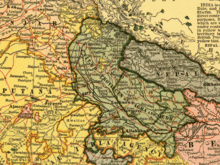History

A stone sculpture (Mahabalipuram) depicting Bhagiratha in penance for the salvation of 60,000 of his ancestors
The region was originally settled by Kols, an aboriginal people of the austro-asiatic physical type who were later joined by Indo-Aryan Khas tribes that arrived from the northwest by the Vedic period. At that time, present-day Uttarakhand also served as a haunt for Rishis and Sadhus. It is believed that Sage Vyasa scripted the Mahabharata here as the Pandavas are believed to have traveled and camped in the region. Among the first major dynasties of Garhwal and Kumaon were the Kunindas in the 2nd century B.C. who practiced an early form of Shaivism. They traded salt with Western Tibet. It is evident from the Ashokan edict at Kalsi in Western Garhwal that Buddhism made inroads in this region. Folk shamanic practices deviating from Hindu orthodoxy also persisted here. However, Garhwal and Kumaon were restored to nominal Brahmanical rule due to the travails of Shankaracharya and the arrival of migrants from the plains. Between the 4th and 14th centuries, the Katyuri dynasty of Khas origin dominated lands of varying extent from the Katyur (modern day Baijnath) valley in Kumaon. The historically significant temples at Jageshwar are believed to have been built by the Katyuris and later remodeled by the Chands. Other peoples of the Tibeto-Burman group known as Kiratas are thought to have settled in the northern highlands as well as in pockets throughout the region, and believed to be the ancestors to the modern day Bhotiya, Raji, Buksha, and Tharu peoples.[6]

Uttarakhand as a part of the United Province, 1903.
In the post-independence period, the Tehri princely state was merged into Uttar Pradesh state, where Uttarakhand composed the Garhwal and Kumaon Divisions.[9] Until 1998, Uttarakhand was the name most commonly used to refer to the region, as various political groups including most significantly the Uttarakhand Kranti Dal (Uttarakhand Revolutionary Party est. 1979), began agitating for separate statehood under its banner. Although the erstwhile hill kingdoms of Garhwal and Kumaon were traditional rivals with diverse lingual and cultural influences due to the proximity of different neighbouring ethnic groups, the inseparable and complementary nature of their geography, economy, culture, language, and traditions created strong bonds between the two regions.[10] These bonds formed the basis of the new political identity of Uttarakhand, which gained significant momentum in 1994, when demand for separate statehood (within the Union of India) achieved almost unanimous acceptance among the local populace as well as political parties at the national level.[11] Most notable incident during this period was the Rampur Tiraha firing case on the night of 1 October 1994, which led to public uproar.[12] On 24 September 1998 Uttar Pradesh Legislative Assembly passed the 'Uttar Pradesh Reorganisation Bill', 1998, which eventually led to the creation of the state,[13] eventually the Parliament passed the Indian Federal Legislation - Uttar Pradesh Reorganisation Act 2000, and thus on 9 November 2000,[14] Uttarakhand became the 27th state in the Republic of India.
However, the term Uttaranchal came into use when the Bharatiya Janata Party (BJP)-led central and Uttar Pradesh state governments initiated a new round of state reorganization in 1998 and introduced its preferred name. Chosen for its allegedly less separatist connotations, the name change generated enormous controversy among the rank and file of the separate state activists who saw it as a political act,[15] however they were not quite as successful as Jharkhand state that successfully thwarted a similar move to impose the name Vananchal. Nevertheless, the name Uttarakhand remained popular in the region, even while Uttaranchal was promulgated through official usage.
In August 2006, India's Union Cabinet assented to the four-year-old demand of the Uttaranchal state assembly and leading members of the Uttarakhand movement to rename Uttaranchal state as Uttarakhand. Legislation to that effect was passed by the State Legislative Assembly in October 2006,[16] and the Union Cabinet brought in the bill in the winter session of Parliament. The bill was passed by Parliament and signed into law by the President in December 2006. Since then, Uttarakhand denotes a state in the Union of India.

No comments:
Post a Comment